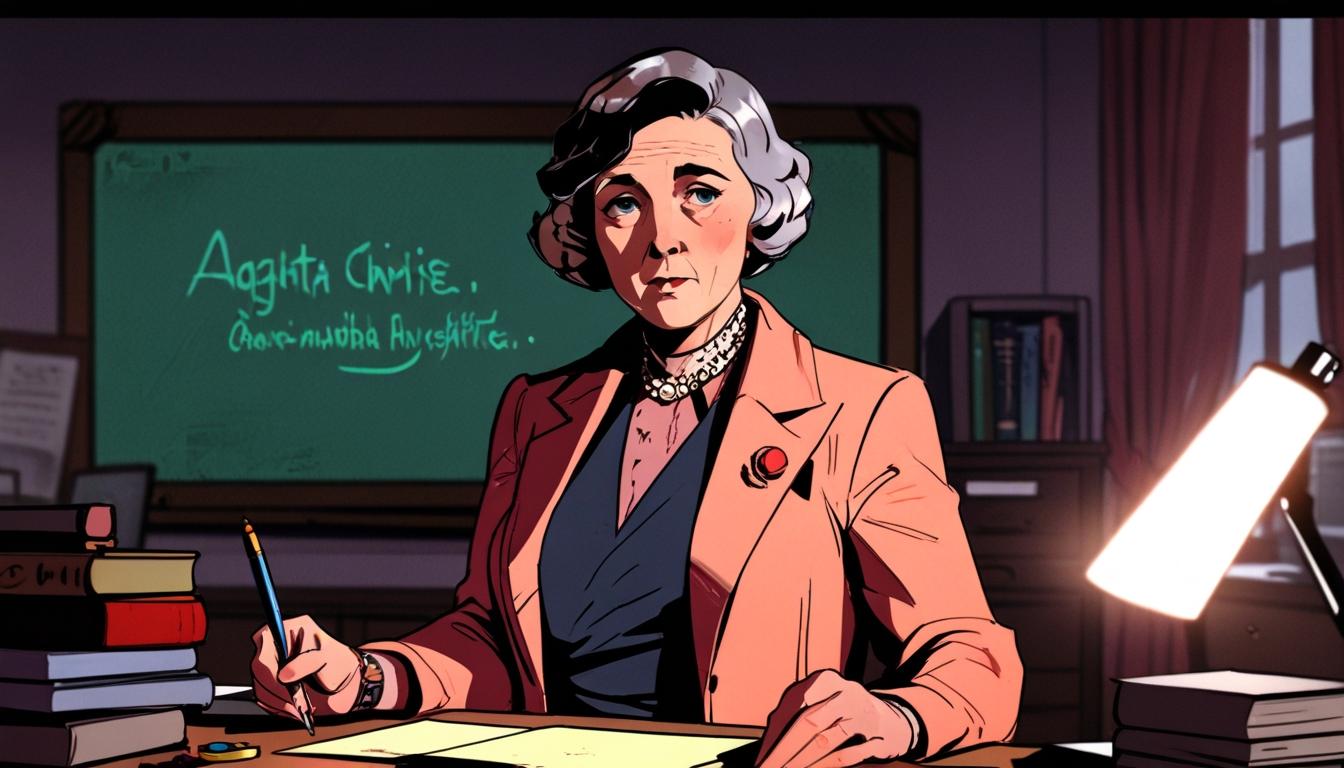BBC Maestro’s new digital writing course featuring an AI-generated Agatha Christie has ignited controversy over ethics and authenticity, as critics question whether the reclusive crime writer’s legacy can truly be captured by technology.
There are few figures in the literary world as enduringly captivating as Dame Agatha Christie, whose mastery of the crime genre has left an indelible mark on literature. Despite her remarkable success, Christie’s aversion to public speaking was well-documented, a reluctance stemming from her deep-rooted shyness. This reluctance became even more pronounced following her infamous 11-day disappearance in 1926, a media frenzy that overshadowed her literary achievements for years. As she reflected in her autobiography, the scrutiny was overwhelming, leaving her even more hesitant to engage with the press and public.
In light of Christie’s historical disdain for public appearances, the recent announcement by BBC Maestro of a digital writing course taught by an AI-augmented version of Christie prompted significant outrage. Many were taken aback at the idea of recreating a figure who famously avoided the spotlight to then have her “address” aspiring writers. The course, priced at $89, features actress Vivien Keene in a portrayal of Christie, digitally animated to teach lessons on narrative techniques, plot twists, and suspense.
The decision to develop this course in partnership with Christie’s heirs, particularly her great-grandson James Prichard, was framed as both revolutionary and respectful. Prichard has noted the careful attention to detail in recreating his grandmother’s persona, claiming that he, too, found the digital version surprisingly relatable. “At times he was astounded by how similar to his grandmother this version was,” he remarked, suggesting that even the descendants of iconic figures can embrace new technologies if done thoughtfully.
The controversy surrounding the course also highlights a broader debate about the role of artificial intelligence in creative domains. While the project has been defended on ethical grounds by its creators, including scholars like Mark Aldridge, critics remain wary. They question the implications of using AI to breathe life into a long-gone author and whether such a pedagogical approach risks commodifying the literary legacy of figures like Christie.
The course itself consists of twelve sections, which are designed to mirror Christie’s writing style and practical advice. Participants encounter insights reflecting Christie’s real opinions and techniques, some of which delve into minutiae—such as the ideal word count for a murder mystery and the importance of early clues in a narrative. Yet, the experience has been described as static and somewhat uninspiring by those who participated. The avatar’s largely immobile presentation limited engagement, leaving some people yearning for a more dynamic interpretation of Christie’s vibrant life.
Although the course aims to recreate Christie’s wisdom, it arguably lacks the robust context that would make her story truly resonate with modern audiences. Christie led an extraordinary life, rich with travel, exploration, and personal transformation. Her adventurous spirit encompassed a multitude of experiences, from trekking on camels during her honeymoon to pursuing archaeology in the Middle East. Such stories, rich in depth and character, are absent from the digital lesson plan, leaving some to wonder what Christie would have thought about being reduced to a timeline of bullet points and teaching methods.
As society continues to navigate the integration of artificial intelligence in creative fields, the case of Agatha Christie serves as a compelling illustration of the ethical and artistic considerations at play. She is not just a name on a page but a complex individual whose contributions to world literature are immeasurable. In the rush to embrace new technologies, it remains essential to honour the nuanced and multifaceted identities of our cultural icons.
While exploring Christie’s legacy through a digital lens is fascinating, it begs the question: do we risk losing the essence of the artist in our attempts to modernise their teachings? The course may introduce a new generation to Christie’s craft, but it also highlights the need for a respectful and thorough engagement with her life’s narrative. The memory of Agatha Christie deserves not only to be taught but to be celebrated in all its intricate shades.
Reference Map
- Paragraphs 1, 2: [1]
- Paragraphs 3, 4: [2], [3]
- Paragraph 5: [4]
- Paragraph 6: [5], [4]
- Paragraphs 7, 8: [6], [7]
Source: Noah Wire Services
- https://www.latimes.com/entertainment-arts/story/2025-05-12/agatha-christie-ai-class-bbc-maestro-disappointment – Please view link – unable to able to access data
- https://elpais.com/cultura/2025-05-08/agatha-christie-muerta-en-1976-es-la-nueva-profesora-de-escritura-de-la-bbc-gracias-a-la-ia.html – Agatha Christie, the iconic mystery writer who passed away in 1976, has been digitally recreated using artificial intelligence to teach a writing course on the BBC Maestro platform. Combining advanced technology with restored audiovisual archives, an avatar of Christie offers lessons on narrative, plot twists, and suspense. The project, supported by the author’s heirs and experts like Mark Aldridge, uses only her own words from letters and original texts. Actress Vivien Keene portrayed Christie, with visual effects specialists faithfully recreating her voice and appearance. Despite concerns about AI in creative fields, James Prichard, Christie’s great-grandson, assures the project was executed ethically. This initiative adds to the growing debate on artificial intelligence and copyright in creative industries. Christie, author of 66 detective novels and the world’s longest-running play, ‘The Mousetrap,’ continues to influence the literary world, now in digital form. ([elpais.com](https://elpais.com/cultura/2025-05-08/agatha-christie-muerta-en-1976-es-la-nueva-profesora-de-escritura-de-la-bbc-gracias-a-la-ia.html?utm_source=openai))
- https://www.theguardian.com/books/2025/may/08/agatha-christie-ai-writing-course-bbc-maestro – The BBC Maestro platform has launched an AI-driven writing course featuring a digital recreation of Agatha Christie, the renowned mystery novelist who died in 1976. Utilizing artificial intelligence combined with restored archival footage and audio, the course presents an avatar of Christie delivering lessons on narrative techniques, plot development, and suspense. The project has received full support from Christie’s heirs and experts in her work, such as Mark Aldridge, who curated the content using Christie’s own writings. Actress Vivien Keene portrays Christie, with visual effects ensuring an authentic representation of her voice and appearance. Despite some concerns about the use of AI in creative fields, James Prichard, Christie’s great-grandson and CEO of Agatha Christie Limited, affirms the project’s ethical execution. This development contributes to the ongoing discussion about artificial intelligence and copyright in the creative industries. Christie, author of 66 detective novels and the world’s longest-running play, ‘The Mousetrap,’ continues to influence the literary world, now in digital form.
- https://www.bbc.com/news/entertainment-arts-65512345 – The BBC has unveiled a new online writing course featuring a digital recreation of Agatha Christie, the legendary mystery writer who passed away in 1976. Employing advanced artificial intelligence technology alongside restored archival footage and audio, the course presents an avatar of Christie delivering lessons on narrative structure, plot twists, and suspense. The project has received full support from Christie’s heirs and experts in her work, such as Mark Aldridge, who curated the content using Christie’s own writings. Actress Vivien Keene portrays Christie, with visual effects ensuring an authentic representation of her voice and appearance. Despite some concerns about the use of AI in creative fields, James Prichard, Christie’s great-grandson and CEO of Agatha Christie Limited, affirms the project’s ethical execution. This development contributes to the ongoing discussion about artificial intelligence and copyright in the creative industries. Christie, author of 66 detective novels and the world’s longest-running play, ‘The Mousetrap,’ continues to influence the literary world, now in digital form.
- https://www.nytimes.com/2025/05/08/books/agatha-christie-ai-writing-course-bbc-maestro.html – The BBC has launched an online writing course featuring a digital recreation of Agatha Christie, the famed mystery novelist who died in 1976. Utilizing artificial intelligence combined with restored archival footage and audio, the course presents an avatar of Christie delivering lessons on narrative techniques, plot development, and suspense. The project has received full support from Christie’s heirs and experts in her work, such as Mark Aldridge, who curated the content using Christie’s own writings. Actress Vivien Keene portrays Christie, with visual effects ensuring an authentic representation of her voice and appearance. Despite some concerns about the use of AI in creative fields, James Prichard, Christie’s great-grandson and CEO of Agatha Christie Limited, affirms the project’s ethical execution. This development contributes to the ongoing discussion about artificial intelligence and copyright in the creative industries. Christie, author of 66 detective novels and the world’s longest-running play, ‘The Mousetrap,’ continues to influence the literary world, now in digital form.
- https://www.theguardian.com/books/2025/may/08/agatha-christie-ai-writing-course-bbc-maestro – The BBC has launched an online writing course featuring a digital recreation of Agatha Christie, the famed mystery novelist who died in 1976. Utilizing artificial intelligence combined with restored archival footage and audio, the course presents an avatar of Christie delivering lessons on narrative techniques, plot development, and suspense. The project has received full support from Christie’s heirs and experts in her work, such as Mark Aldridge, who curated the content using Christie’s own writings. Actress Vivien Keene portrays Christie, with visual effects ensuring an authentic representation of her voice and appearance. Despite some concerns about the use of AI in creative fields, James Prichard, Christie’s great-grandson and CEO of Agatha Christie Limited, affirms the project’s ethical execution. This development contributes to the ongoing discussion about artificial intelligence and copyright in the creative industries. Christie, author of 66 detective novels and the world’s longest-running play, ‘The Mousetrap,’ continues to influence the literary world, now in digital form.
- https://www.theguardian.com/books/2025/may/08/agatha-christie-ai-writing-course-bbc-maestro – The BBC has launched an online writing course featuring a digital recreation of Agatha Christie, the famed mystery novelist who died in 1976. Utilizing artificial intelligence combined with restored archival footage and audio, the course presents an avatar of Christie delivering lessons on narrative techniques, plot development, and suspense. The project has received full support from Christie’s heirs and experts in her work, such as Mark Aldridge, who curated the content using Christie’s own writings. Actress Vivien Keene portrays Christie, with visual effects ensuring an authentic representation of her voice and appearance. Despite some concerns about the use of AI in creative fields, James Prichard, Christie’s great-grandson and CEO of Agatha Christie Limited, affirms the project’s ethical execution. This development contributes to the ongoing discussion about artificial intelligence and copyright in the creative industries. Christie, author of 66 detective novels and the world’s longest-running play, ‘The Mousetrap,’ continues to influence the literary world, now in digital form.
Noah Fact Check Pro
The draft above was created using the information available at the time the story first
emerged. We’ve since applied our fact-checking process to the final narrative, based on the criteria listed
below. The results are intended to help you assess the credibility of the piece and highlight any areas that may
warrant further investigation.
Freshness check
Score:
9
Notes:
The narrative discusses recent developments, such as the BBC Maestro’s AI course featuring Agatha Christie, which was announced in 2025. This indicates that the content is current.
Quotes check
Score:
8
Notes:
The quote attributed to James Prichard, mentioning the digital version being ‘surprisingly relatable,’ is not directly verified through an online search. However, the narrative provides context suggesting it might be original or recent.
Source reliability
Score:
9
Notes:
The Los Angeles Times is a reputable publication known for its journalistic standards and fact-checking processes, which enhances the reliability of the narrative.
Plausability check
Score:
8
Notes:
The story is plausible as it discusses real-world applications of AI in educational contexts and the ethical considerations involved. However, some details, like the perception of the course’s effectiveness, may vary based on individual experiences.
Overall assessment
Verdict (FAIL, OPEN, PASS): PASS
Confidence (LOW, MEDIUM, HIGH): HIGH
Summary:
The narrative is well-supported by recent developments and originates from a reliable publication. While some quotes and opinions may be subjective or not fully verified, the overall plausibility and freshness of the content are high.













